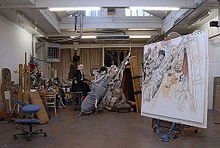Paula Rego
Dame Paula Figueiroa Rego DBE (born January 26, 1935 in Lisbon ) is a contemporary Portuguese painter and graphic artist .
biography
Paula Rego grew up in Lisbon in a wealthy, Anglophile family. From 1945 to 1951 she attended the English school St. Julian's School in Carcavelos near Lisbon. The following year she went to England, where she studied at the Slade School of Fine Art from 1952 to 1956 . It was there that she met her future husband, Victor Willing . After initially commuting between England and their home in Ericeira , Portugal, the couple moved permanently to London in 1975. In 1988 Victor Willing died of complications from multiple sclerosis . In many of her pictures, Paula Rego processed the experiences of suffering and grief made by her husband's illness. She lives in London.
plant
So far, Paula Rego's work can be divided into three major creative periods:
1956 to 1966: Political collages
In her early works from 1956 onwards, Paula Rego mainly worked with collages , which are often assigned to Neo-Dadaism . In the collages she primarily dealt with political issues, in particular the dictatorial regime of Oliveira Salazar in Portugal. Because of the alleged subversiveness of these works, her first solo exhibition in Lisbon in 1965 caused heated controversy.
1966 to 1994: family, oppression, suffering
In 1966, when her husband was diagnosed with multiple sclerosis, Rego changed technique and motives. From now on she devoted herself mainly to painting and graphics. During this time she also developed the magical-realistic style that is typical for her to this day. People (and here almost always women), often entangled in grotesque situations, play a leading role.
At the beginning of the 1980s he created a series of paintings in acrylic colors, which mainly revolved around the themes of family, the role of women, suffering and oppression.
Newer works from 1994: The role of women
At the beginning of the 1990s, Rego again changed her preferred technique. To this day she only uses pastel colors. In her more recent works she repeatedly addresses the feelings of women and their role in society.
A typical work is The Dogwoman (The Dog Woman), which depicts a woman with the shape of a dog. Rego wants this work not only to be understood as symbolic for the humiliation of women - it also expresses aggressiveness, strength, physicality.
Allusions to sexuality and erotic fantasies are unmistakable in many works.
Awards
- 1989 - Nominated for the Turner Prize
- 1995 - Grand Officer of the Order of St. Jacob of the Sword
- 2004 - Grand Cross of the Order of St. Jacob of the Sword
- 2005 - Honorary Doctorate from Oxford University
- 2010 - Adoration as Dame Commander of the Order of the British Empire
- 2011 - Awarded an honorary doctorate from the University of Lisbon (Universidade de Lisboa)
The asteroid (6015) Paularego was named after her.
Exhibitions (selection)
- 1965 - First solo exhibition at the SNBA, Lisbon
- 1988 - Gulbenkian Museum, Lisbon
- 1988 - Serpentine Gallery, London
- 1997 - Tate Gallery, London
- 2004 - Museu Serralves , Porto
- 2007 - Museo Nacional Reina Sofia, Madrid
Web links
- Pictures by Paula Rego in the Berardo Collection, Lisbon (English / Portuguese)
- Interview with Paula Rego BBC (English).
- Paula Rego Saatchi Gallery
Individual evidence
- ↑ Short portrait of the BBC about Paula Rego (English) ( Memento of 8 February 2008 at the Internet Archive )
- ↑ work division in the Paula Rego retrospective at the Tate Gallery, London (English) ( Memento of 24 November 2007 at the Internet Archive )
- ↑ Thinkquest page about Paula Rego's Dogwoman ( Memento from October 7, 2007 in the Internet Archive )
- ↑ Nomination Turner Prize, 1989 ( Memento from May 2, 2009 in the Internet Archive )
- ^ Tate, 1996/97 ( Memento of December 7, 2011 in the Internet Archive )
- ↑ Overview of Paula Rego's exhibitions on art aspects
- ↑ A Portuguese woman on the trail of Goya and Picasso , portugalmania.de
| personal data | |
|---|---|
| SURNAME | Rego, Paula |
| ALTERNATIVE NAMES | Rego, Paula Figueiroa (full name) |
| BRIEF DESCRIPTION | Portuguese painter and graphic artist |
| DATE OF BIRTH | January 26, 1935 |
| PLACE OF BIRTH | Lisbon , Portugal |
